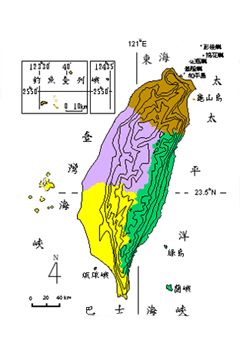Taiwan's Environmental Problems

Relevant Websites
- Environmental Protection Administration Government of R.O.C.
- Nong-wei-hui-zi-ran-bao-yu-wang
- Quan-qiu-huan-jing-bian-qian-zi-xun-xi-tong
- Global Change Information System
Reference
- Environmental Protection Administration Government of R.O.C. edited, 1995: Zhong-hua-min-guo-tai-wan-di-qu-huan-jing-zi-xun, Taipei, Environmental Protection Administration Government of R.O.C, pp. 25-30; 289-295.
- Lue, Kuang-yang, 1984: Tai-wan-zhi-sheng-tai-jian-jie, Guo-min-lu-you-cong-shu, Tourism Bureau of Ministry of Transportation and Communication, pp. 11-79.
- Cheng, Flora Sheng-hua, 1995: Tai-wan-ye-sheng-dong-zhi-wu-ji-bao-yu, Di-li-ke-bu-chong-jiao-cai(xia), Taipei, National Institute for Compilation and Translation, pp. 225-254.
Taiwan's Environmental Problems According to Geographical Region
A. Mountains─Development of transportation, agriculture, and tourism leads to pollution.
Taiwan's mountains are important as a water source (rivers begin from mountain springs), and for their support of forests, bird and animal life; they are also the traditional homelands of aboriginal peoples. When the Northern, Central and Southern Cross-Island Highways were completed in the 1960s and 1970s, the aborigines' life was improved but the landscape along the highways also changed. As many people came to take advantage of the mountains' resources, environmental problems were created: water pollution, soil erosion, landslides, forest fires, sedimentation of reservoirs (water sources), and flooding at the middle and lower altitudes. Now the mountain ecosystem is under increasing pressure; some areas of the land are threatened with destruction, and some wildlife species are threatened with extinction.
B. Hills-Overdevelopment endangers the midstream and downstream catchment areas.
Taiwan's hills have been overdeveloped for the sake of agricultural, residential, industrial and recreational uses (e.g. golf courses). Together with the problems of water pollution, air pollution, soil pollution and solid waste disposal, the ecological system in midstream and downstream catchment areas has been seriously undermined. Pig farmers' careless handling of wastewater and tea and fruit growers' use of chemicals to improve their yield in these regions also can lead to polluted water for downstream city users.
C. Plains and Basins-All sorts of pollution and proliferation of garbage cause environmental problems.
This region faces the most serious threat from industrialization and urbanization. Metropolitan cities like Taipei and Kaohsiung struggle with dangerous levels of air, water and noise pollution; the disposal of solid and toxic wastes in a safe and clean manner remains a problem. On average each person produces 1.13 kilograms of garbage a day; this stretches to the limit the capacity of the environment to absorb waste safely.
D. Coasts-It is urgent that we reduce pollution produced by large facilities at river mouths and along the coasts.
Economic activity has always started early in coastal areas. Today large facilities like nuclear power plants, international airports, commercial ports, fishing harbors, industrial parks and fish farms are having a complex impact on the coastal environment. To control the pollution at the mouths of rivers in western Taiwan is a particularly pressing problem.
E. Outlying Islets-The environmental threat of population growth and nuclear waste clouds the future.
Although the economy of the outlying islets relies on a pollution-free industry, namely tourism, the natural population growth rate in this region is high and the islets have long been considered the most suitable potential dumpsite for nuclear waste. The islets, being isolated, are fragile ecosystems. For places like Lan Yu (Orchid Island) the threats to the environment are immediate and very real.